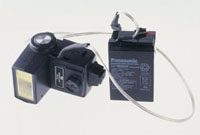How To
Build A Battery Pack For Your Flash
Of all the articles that
I have written for Shutterbug, there is one topic that continually generates
mail from readers. Whenever I have mentioned my "homemade battery
packs" for Vivitar 283 and 285 flash units, the mail pours in.
Sick of poky alkalines, short-lived NiCds? Well Vivitar owners, here
we go. |
|||
I first built my own battery
pack for a flash that had no external battery options. My Osram BCS-44
flash units packed a punch, but had no support from the external battery
manufacturers. Since I was stuck with a great flash unit that drained
NiCds in about 50 flashes, I took matters into my own hands. I unscrewed
every screw I could find on the flash, gently cracked the case, and found
the + and - terminals for the battery compartment. Adding a short pigtail
and a Radio Shack Molex connector, I now had a way to patch in an external
battery. I quickly learned the maximum limits for battery power. While
1.2, 2.3, 3.5, and 4amp 6v batteries worked great, a small motorcycle
battery produced such a strong jolt that I overheated the flash caps and
actually melted the plastic case. (I went back to a smaller battery and
still use the unit today--15 years later.) |
|||
A correctly functioning Vivitar
283 or 285 will recycle with alkaline batteries in about 8 sec; about
6 sec with 500 mAh NiCds; and around 5 sec with high capacity 1100 mAh
NiCds. While other high capacity AA batteries like 1300 mAh NiMH batteries
will give you slightly better battery life and virtually no battery "memory,"
they still won't do much better than 5 sec and give you about 50
flashes or so before the recycle time begins to drag. (Ever ask a lot
of people all dressed up at a wedding or other family function to wait
until your orange light came back on? Even 12 sec can feel like an eternity.)
|
|||
Once you have a battery and
a charger, you'll need to figure out how to get your power into
the flash unit. The external connections on most shoe mount flash units
are for high voltage battery packs like the Lumedyne Mincycler or the
Dyna-Lite Jackrabbit. We're only using 6v, so we'll need to
get the power into the low voltage taps. The easiest and most reversible
method is to simply sacrifice a battery holder and fashion a cable. For
cable I have used everything from heavy-duty monster cable to regular
old 18 gauge zip cord. The heavy cable will pass more current and give
you slightly faster recycle times, but it can be a pain to use. |
|||
With the fuses inserted into
the holder and a recess melted in the plastic, it's time to carefully
slip the holder into the battery cavity. Once it is pushed down all the
way just slide the battery door as far as you can go. I stick a couple
of pieces of gaffer tape over the door and leave it at that. If you're
looking for a slicker installation you can drill or melt the appropriate
cutout to allow the cable to stick out of the battery compartment through
the closed door. If you're neat and clean about it, you'll
be able to switch back and forth from NiCds to the lead acid supply with
no problem. If your flash doesn't have a battery holder, then you
can place the fuses over the terminals which deliver + and - to the flash,
then stuff the rest of the cavity with black weather stripping foam. When
it seems very tight, close the battery compartment as far as you can and
rubber band or tape it shut. It's not the most elegant solution,
but it works. |
|||
Once you have everything together,
get a voltmeter and very carefully check your polarity. The battery comes
from the store with a little bit of juice in it, certainly enough to test.
I always set the + side of the Molex connector as the "pointy"
side, the - side as flat. Hook up your cable and place the ends of the
voltmeter on the ends of the fuses. The fuse end that is located in the
+ side of the holder should be touching the red wire of the voltmeter.
With an uncharged battery you should see positive 4-6v. If you see any
negative voltage--stop. Rewire your cable to get it right. Hooking up
this kind of power backward will blow your flash to bits in a fraction
of a second. |
- Log in or register to post comments


Do not use speaker wire. Speaker has an impedance which is another word for resistance which can cause heat and might start a fire. There are several good coiled cords you can buy for this.







































